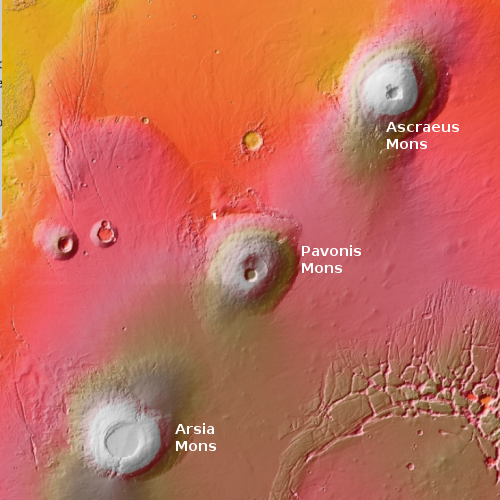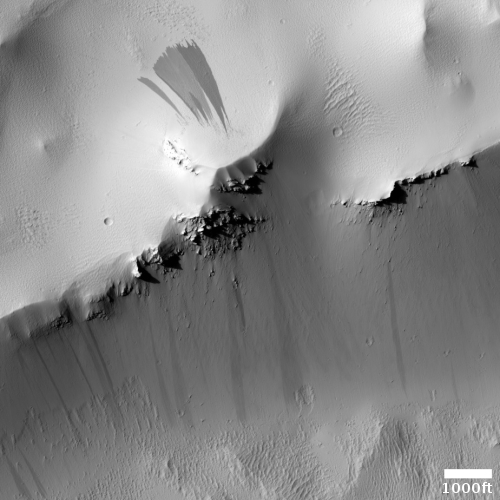Slope streaks in frozen lava flows on Mars
Cool image time! The photo to the right, cropped and reduced to post here, was taken on June 5, 2021 by the high resolution camera on Mars Reconnaissance Orbiter (MRO). It shows a ridgeline at the base of the giant volcano Pavonis Mons, with slope streaks on ridge’s north and south sides.
Slope streaks are a mysterious phenomenon unique to Mars. While they resemble an avalanche, they do not change the topography of the surface at all. They appear to occur randomly year round, fading slowly with time. Also, while most are dark, scientists have also spotted bright slope streaks as well.
Slope streaks also only appear on surfaces covered with a layer of fine dust, something that is obviously the case in the cool image to the right. There is so much dust on the surface here that bedrock only appears at the top of the ridge, peeking out in only a few places.
The location of this image, as shown in the overview map below, adds some additional details.

Pavonis Mons is the central volcano of the three that sit between the giant canyon Valles Marineris to the east and Mars’ biggest volcano, Olympus Mons, to the west. The white rectangle marks the location of this photo, at the very base of Pavonis.
Thus, under the fine dust layers that allowed the formation of these slope streaks it is likely that all the rock is volcanic in nature, part of the vast lava flows that came down this volcano more than a billion years ago.
Why there is a ridge here is a little unclear. It appears that as the lava flowed downhill, it might have pushed debris in front of it, which piled up to form this higher ridge. (That is a pure uneducated guess, however.) Later, the dust piled up on the surface, allowing for slope streaks to appear periodically, likely instigated by a small rock fall at the top.
As for the streaks, the process that forms them remains unknown. Several theories have been proposed (dust flows, brine flows) but none really fits all the facts. They remain one of Mars’ many geological mysteries.
On Christmas Eve 1968 three Americans became the first humans to visit another world. What they did to celebrate was unexpected and profound, and will be remembered throughout all human history. Genesis: the Story of Apollo 8, Robert Zimmerman's classic history of humanity's first journey to another world, tells that story, and it is now available as both an ebook and an audiobook, both with a foreword by Valerie Anders and a new introduction by Robert Zimmerman.
The print edition can be purchased at Amazon or from any other book seller. If you want an autographed copy the price is $60 for the hardback and $45 for the paperback, plus $8 shipping for each. Go here for purchasing details. The ebook is available everywhere for $5.99 (before discount) at amazon, or direct from my ebook publisher, ebookit. If you buy it from ebookit you don't support the big tech companies and the author gets a bigger cut much sooner.
The audiobook is also available at all these vendors, and is also free with a 30-day trial membership to Audible.
"Not simply about one mission, [Genesis] is also the history of America's quest for the moon... Zimmerman has done a masterful job of tying disparate events together into a solid account of one of America's greatest human triumphs."--San Antonio Express-News
Cool image time! The photo to the right, cropped and reduced to post here, was taken on June 5, 2021 by the high resolution camera on Mars Reconnaissance Orbiter (MRO). It shows a ridgeline at the base of the giant volcano Pavonis Mons, with slope streaks on ridge’s north and south sides.
Slope streaks are a mysterious phenomenon unique to Mars. While they resemble an avalanche, they do not change the topography of the surface at all. They appear to occur randomly year round, fading slowly with time. Also, while most are dark, scientists have also spotted bright slope streaks as well.
Slope streaks also only appear on surfaces covered with a layer of fine dust, something that is obviously the case in the cool image to the right. There is so much dust on the surface here that bedrock only appears at the top of the ridge, peeking out in only a few places.
The location of this image, as shown in the overview map below, adds some additional details.

Pavonis Mons is the central volcano of the three that sit between the giant canyon Valles Marineris to the east and Mars’ biggest volcano, Olympus Mons, to the west. The white rectangle marks the location of this photo, at the very base of Pavonis.
Thus, under the fine dust layers that allowed the formation of these slope streaks it is likely that all the rock is volcanic in nature, part of the vast lava flows that came down this volcano more than a billion years ago.
Why there is a ridge here is a little unclear. It appears that as the lava flowed downhill, it might have pushed debris in front of it, which piled up to form this higher ridge. (That is a pure uneducated guess, however.) Later, the dust piled up on the surface, allowing for slope streaks to appear periodically, likely instigated by a small rock fall at the top.
As for the streaks, the process that forms them remains unknown. Several theories have been proposed (dust flows, brine flows) but none really fits all the facts. They remain one of Mars’ many geological mysteries.
On Christmas Eve 1968 three Americans became the first humans to visit another world. What they did to celebrate was unexpected and profound, and will be remembered throughout all human history. Genesis: the Story of Apollo 8, Robert Zimmerman's classic history of humanity's first journey to another world, tells that story, and it is now available as both an ebook and an audiobook, both with a foreword by Valerie Anders and a new introduction by Robert Zimmerman.
The print edition can be purchased at Amazon or from any other book seller. If you want an autographed copy the price is $60 for the hardback and $45 for the paperback, plus $8 shipping for each. Go here for purchasing details. The ebook is available everywhere for $5.99 (before discount) at amazon, or direct from my ebook publisher, ebookit. If you buy it from ebookit you don't support the big tech companies and the author gets a bigger cut much sooner.
The audiobook is also available at all these vendors, and is also free with a 30-day trial membership to Audible.
"Not simply about one mission, [Genesis] is also the history of America's quest for the moon... Zimmerman has done a masterful job of tying disparate events together into a solid account of one of America's greatest human triumphs."--San Antonio Express-News



It seems to be “leaking” into a circular feature… That’s the only solution I can come up with.., another asteroid impact.,..